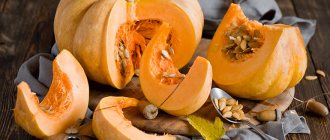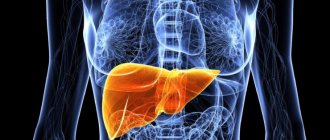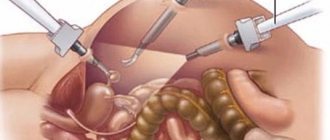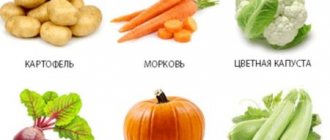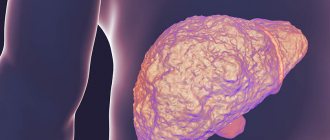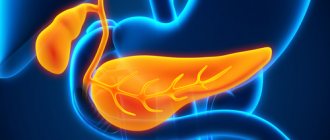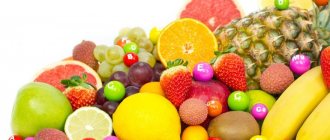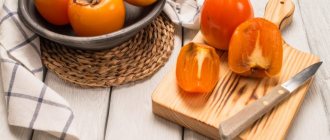Who is the diet for?
A special diet is selected for treatment and prevention for patients diagnosed with liver disease. With the development of hepatitis and other pathologies, proper nutrition is required so that the patient’s condition is not aggravated by harmful microelements that enter the body with food. Alcohol, tobacco products, overeating, fatty or smoked foods lead to disruptions in the body. The diet restrains destructive processes, the work of all organs is resumed.
The need for diet for diseases of the liver and pancreas
The main liver disease - hepatitis - can have any source - viruses, poisoning with toxic substances, radiation. In acute forms of the disease, as well as exacerbations of pancreatitis, nutritional plan No. 5A is prescribed. It also helps with other pancreatic diseases. All these serious illnesses can correct the mechanism for assimilation of necessary substances obtained from food, not in the best direction.
Dietary restrictions are needed to ease the load on the affected organs, and to give them time and strength to reanimate.
In addition, the task of the diet table is to saturate the body with useful minerals and vitamins for quick recovery. Special nutrition is designed to provide internal organs and systems with the required number of calories, minerals and vitamins. During the day you should eat about a gram of protein per kilogram of weight. The menu must be agreed upon with a nutritionist, who will recommend certain products depending on the type and degree of progression of the pathology. You may have to salt your food less and expand your diet with healthy additives. In addition, those suffering from gallbladder or liver diseases are advised to eat foods rich in folic acid and lycopene.
We also recommend viewing: Traditional methods of treating the pancreas
What awaits the patient if he does not follow dietary recommendations?
Every person has the opportunity to act in life as he considers right, to eat any product. But many are not sufficiently informed about various issues and may make the wrong choice. If you look at the statistics, you can conclude that most people ignore advice on healthy eating.
A diet for liver and pancreas disease is designed to relieve stress on the organs. The load on the digestive system may be too great, resulting in pathology. If you do not follow dietary recommendations and eat food out of habit, the disease worsens and an exacerbation occurs.
The following symptoms appear:
- Strong pain.
- Vomiting.
Often people have to be taken to the hospital, they don’t eat anything, they feel hungry. Not everyone wants to experience such a state. As pathology develops, complications arise and sometimes surgery is necessary.
Authorized Products
Diet for liver and pancreas disease includes:
- Soups in vegetable broths with vegetables (in case of exacerbation - ground). Cereal soups are well boiled or kneaded, seasoned with sour cream, butter or cream. The most acceptable for these diseases are puree soups.
- Boiled and grated (in case of exacerbation) potatoes, pumpkin, zucchini, carrots, cauliflower, beets, green peas. After a while, the consumption of finely chopped boiled vegetables is allowed, and during the period of remission - raw (grated carrots, cucumbers and pumpkin, peeled tomatoes).
- Porridge with water: semolina, oatmeal, buckwheat, rice. Pearl barley, corn, millet and barley are limited. Porridges are well boiled or ground, and also prepared from flour (buckwheat, oatmeal, rice) with the addition of milk. You can make a soufflé from cereals, pouring jelly or jam.
- Lean chicken, beef, veal or rabbit. Boiled chicken and rabbit are consumed in pieces; other types of meat are prepared in the form of chopped, steamed products.
- Low-fat fish (pike perch, hake, cod, pollock, perch, carp, pike, whiting), steamed - in pieces or in the form of cutlets. For pancreatitis, stewed and poached fish is not allowed, as it contains a large amount of extractive substances.
- Low-fat fermented milk products. Sour cream and milk are allowed as additives in dishes, since whole milk is poorly tolerated. You can include mild grated cheese, low-fat cottage cheese and dishes made from it in your diet. In case of calcium deficiency, which is observed in patients with pancreatitis, it is better to consume calcined cottage cheese.
- Wheat bread, dried or crackers. It is possible to eat unsweetened cookies.
- White omelettes from 1-2 eggs daily.
- Vegetable-based sauces that diversify your diet. They are prepared on the basis of unfried flour with the addition of sour cream or milk.
- Baked sweet apples and pears and pureed dried fruits. Jams, jelly, mousses and natural marshmallows prepared with xylitol. Mashed raw fruits are allowed to a limited extent.
- For liver diseases, the list of fruits is wider - all ripe fruits (except sour varieties) are allowed, baked and raw.
Table of permitted products
| Proteins, g | Fats, g | Carbohydrates, g | Calories, kcal | |
Vegetables and greens | ||||
| eggplant | 1,2 | 0,1 | 4,5 | 24 |
| zucchini | 0,6 | 0,3 | 4,6 | 24 |
| cabbage | 1,8 | 0,1 | 4,7 | 27 |
| broccoli | 3,0 | 0,4 | 5,2 | 28 |
| carrot | 1,3 | 0,1 | 6,9 | 32 |
| cucumbers | 0,8 | 0,1 | 2,8 | 15 |
| parsley | 3,7 | 0,4 | 7,6 | 47 |
| tomatoes | 0,6 | 0,2 | 4,2 | 20 |
| pumpkin | 1,3 | 0,3 | 7,7 | 28 |
| dill | 2,5 | 0,5 | 6,3 | 38 |
Fruits | ||||
| bananas | 1,5 | 0,2 | 21,8 | 95 |
| pears | 0,4 | 0,3 | 10,9 | 42 |
| apples | 0,4 | 0,4 | 9,8 | 47 |
Nuts and dried fruits | ||||
| raisin | 2,9 | 0,6 | 66,0 | 264 |
| dried figs | 3,1 | 0,8 | 57,9 | 257 |
| dried apricots | 5,2 | 0,3 | 51,0 | 215 |
| dried apricots | 5,0 | 0,4 | 50,6 | 213 |
| prunes | 2,3 | 0,7 | 57,5 | 231 |
Cereals and porridges | ||||
| buckwheat (kernel) | 12,6 | 3,3 | 62,1 | 313 |
| oat groats | 12,3 | 6,1 | 59,5 | 342 |
| rice | 6,7 | 0,7 | 78,9 | 344 |
Flour and pasta | ||||
| pasta | 10,4 | 1,1 | 69,7 | 337 |
| noodles | 12,0 | 3,7 | 60,1 | 322 |
| buckwheat noodles | 14,7 | 0,9 | 70,5 | 348 |
Bakery products | ||||
| bran bread | 7,5 | 1,3 | 45,2 | 227 |
| whole grain bread | 10,1 | 2,3 | 57,1 | 295 |
Confectionery | ||||
| jam | 0,3 | 0,2 | 63,0 | 263 |
| jelly | 2,7 | 0,0 | 17,9 | 79 |
| marshmallows | 0,8 | 0,0 | 78,5 | 304 |
| fruit and berry marmalade | 0,4 | 0,0 | 76,6 | 293 |
| paste | 0,5 | 0,0 | 80,8 | 310 |
| Maria cookies | 8,7 | 8,8 | 70,9 | 400 |
Raw materials and seasonings | ||||
| honey | 0,8 | 0,0 | 81,5 | 329 |
| sugar | 0,0 | 0,0 | 99,7 | 398 |
Dairy | ||||
| kefir 1.5% | 3,3 | 1,5 | 3,6 | 41 |
| Ryazhenka | 2,8 | 4,0 | 4,2 | 67 |
Cheeses and cottage cheese | ||||
| cottage cheese 1% | 16,3 | 1,0 | 1,3 | 79 |
Meat products | ||||
| beef | 18,9 | 19,4 | 0,0 | 187 |
| rabbit | 21,0 | 8,0 | 0,0 | 156 |
Bird | ||||
| boiled chicken breast | 29,8 | 1,8 | 0,5 | 137 |
| boiled chicken drumstick | 27,0 | 5,6 | 0,0 | 158 |
| boiled turkey fillet | 25,0 | 1,0 | — | 130 |
Eggs | ||||
| soft-boiled chicken eggs | 12,8 | 11,6 | 0,8 | 159 |
Fish and seafood | ||||
| flounder | 16,5 | 1,8 | 0,0 | 83 |
| pollock | 15,9 | 0,9 | 0,0 | 72 |
| cod | 17,7 | 0,7 | — | 78 |
| hake | 16,6 | 2,2 | 0,0 | 86 |
Oils and fats | ||||
| butter | 0,5 | 82,5 | 0,8 | 748 |
| olive oil | 0,0 | 99,8 | 0,0 | 898 |
| sunflower oil | 0,0 | 99,9 | 0,0 | 899 |
Non-alcoholic drinks | ||||
| water | 0,0 | 0,0 | 0,0 | — |
| mineral water | 0,0 | 0,0 | 0,0 | — |
| green tea | 0,0 | 0,0 | 0,0 | — |
Juices and compotes | ||||
| apricot juice | 0,9 | 0,1 | 9,0 | 38 |
| carrot juice | 1,1 | 0,1 | 6,4 | 28 |
| peach juice | 0,9 | 0,1 | 9,5 | 40 |
| plum juice | 0,8 | 0,0 | 9,6 | 39 |
| tomato juice | 1,1 | 0,2 | 3,8 | 21 |
| pumpkin juice | 0,0 | 0,0 | 9,0 | 38 |
| rose hip juice | 0,1 | 0,0 | 17,6 | 70 |
| * data is per 100 g of product | ||||
Food frequency
Nutrition for pathologies of the liver and pancreas involves eating foods in small portions often. For normal saturation with useful microelements, the body will not have enough portions of 200-300 g, since adult patients should eat approximately 3000 kilocalories per day. Therefore, the main dietary recommendation that helps in the treatment of the digestive system is split meals five times a day. With this mode, there are 3 main and 2 intermediate techniques.
Principles of diet for organ pathologies
Nutrition for joint pathology of the liver and diseases of the pancreas has no fundamental differences. It is based on the saturation of the affected organs with a sufficient amount of easily digestible proteins, vitamins and useful minerals.
In case of liver pathology, fiber is needed, which is not indicated during periods of severe exacerbation of pancreatitis. Products that increase the secretion of digestive juice must be limited or completely eliminated. They also act as risk factors for the development of inflammation in the liver. The principles of a proper diet include:
- frequent and fractional (small portions) meals,
- crushed and pureed food into a puree,
- the temperature of the prepared dishes should be comfortable to maximize the sparing of the digestive organs; hot or cold food is unacceptable.
Food processing plays an important role: they are boiled, stewed, or cooked in a double boiler. Frying is strictly not recommended - this is the most harmful way of cooking for the health of the digestive organs. The second place is occupied by fatty foods, which can provoke active hepatitis, exacerbation of pancreatitis, and when consuming large amounts of fat, pancreatic necrosis develops.
What foods are allowed for illnesses?
In case of pathology of the digestive organs, including damage to the liver and pancreas, it is necessary to use a diet specially developed for these cases - table No. 5 according to Pevzner. It contains the following list of useful foods for the liver, taking into account damage to the pancreas:
- lean meats and fish,
- low-calorie fermented milk products, low-fat milk,
- lightly dried bread or crackers,
- vegetables prepared by baking, boiling, stewing,
- fruits - after similar processing, but in case of hepatitis they can be eaten raw in small quantities; in case of severe pancreatitis this is contraindicated,
- cereals (the basis of the diet is rice, buckwheat, oatmeal, semolina),
- soups based on the listed cereals, cooked in water or vegetable broth,
- jelly, dried fruit compotes, juices,
- omelette made from egg whites (hard-boiled ones are excluded),
- oil - a small amount with a predominance of vegetable oil.
Prohibited Products
Prohibited foods include everything fatty, fried, spicy, smoked, canned, and too salty. Every person suffering from impaired liver function should know the list of unhealthy foods that cause fatty liver, or develop hepatomegaly - enlarged liver. With excessive consumption of certain foods, a diffuse process occurs in the tissues of the affected organs, leading to irreversible consequences, since normal cells are replaced by connective tissue. Complaints appear, inflammation intensifies, pain in the hypochondrium begins, any symptom worsens, treatment becomes more complicated and prolonged. Indigestion leads to the fact that the pathology spreads to other organs (stomach, gall bladder).
According to statistics, the incidence of diseases of the digestive system has increased significantly recently. Many factors contribute to this, primarily alcohol. A hangover is severe and requires additional treatment. The problem is so serious that cirrhosis - cancer - can become a complication of hepatitis. Oncology occupies a significant place in the structure of morbidity of the liver and pancreas. Therefore, at any stage of the disease it is necessary to maintain a healthy lifestyle.
All of the listed pathological conditions require the exclusion of a significant portion of products from consumption. There is a special table indicating harmful foods that you can use when preparing dishes. Prohibited for use:
- fresh wheat bread, baked goods, confectionery (cakes, pastries), fried flour products (pancakes, donuts, pies),
- fried and hard-boiled eggs,
- legumes - all their types,
- porridge from corn, barley, pearl barley,
- unprocessed vegetables and fruits,
- fatty meat, including duck, goose,
- concentrated broths from mushrooms, meat, fatty fish,
- alcohol, strong tea, cocoa, coffee, sour drinks, chocolate.
A diseased liver does not tolerate sausages and canned food. Do not use hot seasonings - they stimulate the production of pancreatic juice, which leads to an exacerbation of pancreatitis.
Diet No. 5
If you have pancreatic or liver disorders, you need to chop foods, grate vegetables, fruits, or beat them in a blender. Then you will have to chew your food thoroughly. Billiard diet, formulated for the treatment of the gallbladder. It is not advisable to consume anything between approved doses. If you are hungry, it is better to drink water. You need to drink a lot of fluids, about 1.5 liters a day.
Diet for a week
With this diet you need to eat 5 times a day. We list the recommended food products.
First day:
- Low-fat cottage cheese with the addition of berries. Thick buckwheat porridge, a little butter. You can drink tea.
- Grated apple.
- Soup with boiled vegetables, low-fat meat, vermicelli, jelly.
- Not too strong tea, biscuits.
- Boiled potatoes and steamed fish, kefir.
Second day:
- Vermicelli with chicken.
- Low-fat cottage cheese with raisins.
- Soup with vegetables and potatoes.
- You can cook cabbage rolls with the addition of chicken.
- Boiled rice with milk.
Day three:
- Oatmeal with milk, fish, weak tea.
- Pasta soup, meat and vegetables, washed down with jelly.
- Tea with marmalade.
- Cheese, pasta with added butter.
Fourth day:
- Buckwheat with chicken.
- Cottage cheese with crushed banana.
- Cutlets, soup, compote.
- Low-fat kefir, you can eat some berries.
- Boiled rice with applesauce, washed down with tea.
Fifth day:
- Kissel, berries, oatmeal.
- Vegetables cooked in a blender.
- Rabbit meat.
- Biscuits with kefir.
- Buckwheat porridge with fish.
Sixth day:
- Rice and banana.
- Apple.
- Chicken and shredded broccoli.
- Fish, pasta, jelly.
Seventh day:
- Buckwheat with butter and carrots.
- Grated apples and banana.
- Soup with potatoes and cheese.
- Cottage cheese with berries.
- Rice with banana.
The patient will have to follow the doctor's instructions, eat only what he says. The break between meals should be approximately 3 hours, and you should drink 1.5 liters of water per day. You need to eat regular food without gas; the diet must include compotes, jelly, freshly squeezed juices, berries, which stabilize the functions of the liver and pancreas.
Nutrition rules for diet No. 5
For diseases of the hepatobiliary system, there are general recommendations that will reduce the severity of the inflammatory process:
- remove from the diet foods that increase the secretion of gastric juice. These are vegetables with essential oils (garlic, onion, radish, radish, celery), rich broths, dried and smoked products;
- components that mechanically irritate the gastrointestinal mucosa should be excluded. Such products include vegetables with coarse fiber, meat with veins and tendons, baked goods made from wholemeal flour;
- dishes are prepared in a double boiler or boiled. You can bake only if the disease is in remission; you cannot eat the resulting crust;
- the volume of refractory and poorly broken down fats is reduced, they are replaced with vegetable oils. In case of inflammation of the pancreas and deposition of gallstones, the total amount of fat in the diet should be reduced;
- Foods with a high quantity of purines are removed from the diet. This is young stock meat, liver and other offal, sardines, tuna, herring, sprats, salmon, shrimp, seafood, dried porcini mushrooms, yeast, smoked eel;
- the use of table salt is limited, since it affects the quality of bile (causes its thickening), which slows down its outflow;
- the amount of foods with lipotropic properties in the diet increases (beef, lean fish, cottage cheese, whey, buckwheat, soy flour). Thanks to this, lipolysis in liver cells is normalized and the likelihood of developing fatty hepatosis is reduced;
- meals must be fractional, so that bile and enzymes do not accumulate in the glands, but are released into the duodenum. For pancreatitis, it is recommended to eat every two hours, but in portions of 50–100 grams;
- during the period of relapse, as well as in case of severe inflammation of the liver and pancreas, all products should be ground to speed up their breakdown and reduce the mechanical load on the digestive tract.
Dish recipes
A properly formulated diet for liver pathologies is based on a reasonable approach to one’s own health and food intake. You need to understand that all pathologies of internal organs require adherence to a separately formulated diet. While following doctors’ recommendations, it is unacceptable to refuse medications or take prescribed pills and other medications in a timely manner.
Let's list a few useful recipes.
Buckwheat soup:
- you need 100 ml of boiling water;
- add about 50 g of buckwheat;
- cook for 15 minutes.
After cooking, add a little skim milk to the pan and stir everything. Lightly salt the soup and serve with a small amount of butter.
Perch with side dish:
- The fish is cleaned and washed.
- Cut into several pieces and cook.
- You can use rice as a side dish.
- Add some grated carrots on top.
Diet cake:
- dissolve 2 packs of gelatin in boiled water; when the liquid has cooled, pour it into the yogurt;
- Cookies are placed in a baking dish, then the milk ingredient is poured. You can do this in several layers;
- The cake is sprinkled with fruits and berries on top.
Shrimp soup:
- Potatoes and zucchini can be chopped in a blender.
- Add 10 and 15 boiled shrimp there.
- Mix milk with water, open for a few minutes, add vegetables.
- Wait for the mixture to boil again, cook for about 15 minutes.
- Add parsley, dill, and some shrimp, and boil for another three minutes.
Diet table
Since for diseases of the liver and pancreas it is recommended to eat 5 times a day, there is no need for a nutritious breakfast and a set lunch. That is, it is enough to eat a salad for lunch and only soup or a side dish for lunch. However, in general, the daily diet should be varied, high-calorie and balanced. Snacks (lunch, afternoon snack) can be in the form of fresh fruits and vegetables, tea (herbal tea, rose hips, chicory), pudding or kefir with crackers. And dishes for breakfast, lunch and dinner should be more filling. This table will help you make your diet varied:
| Breakfast | Dinner | Dinner |
| milk porridge (rice, buckwheat, semolina) with sugar or honey, | boiled fish or meat (chicken, veal, turkey), | vegetable puree, salad or stew, |
| mashed potatoes, | side dish (cereals, pasta), | white omelette, |
| white omelette, | light soups, | boiled fish, |
| cereals, muesli, | salads (vegetables, fruits), | porridge with dried fruits, |
| cabbage cutlets, | steamed cutlets, | pudding, |
| curd cheese pancakes, | doctor's sausage, | warm milk with honey, |
| Herb tea. | compote, jelly, juice. | kefir, chamomile tea. |
Doctors' recommendations
The compiled menu for a week for pancreatic pathology includes products that nutritionists allow for consumption. Patients are not recommended to adjust their diet on their own. In this case, the disease may worsen, and the course of therapy will have to be extended. To prepare dietary food, it is advisable to use ready-made recipes developed by nutritionists; it is not advisable to invent anything.
Oil should not be consumed; all plant products must be steamed. The dishes included in such a diet may be different, so the patient does not face a lack of vitamins. All products are tasty, contain useful microelements, and are easily digested.
Easy and healthy recipes
Despite the large number of restrictions, a diet for diseases of the liver and pancreas can be healthy, tasty, and varied. It’s worth adding a few simple and delicious recipes to your cookbook:
| Dish | Ingredients | Preparation |
| First (Soups) | ||
| Buckwheat soup | buckwheat - 50 g, water - 100 ml, milk - 400 ml. | Throw the cereal into boiling water and cook for 15 minutes, then add milk and a little honey or sugar. Serve with butter. |
| Cream soup | beef - 100 g, zucchini - 200 g, milk - 70 ml, yolk - 1 pc. | Grind the boiled beef in a blender, add water and simmer. Do the same with zucchini. Mix milk with egg yolk and pour into zucchini, then add meat. Simmer for a couple more minutes without boiling. |
| cauliflower - 1 pc., chicken fillet - ½ pc., milk -70 ml, yolk - 1 pc. | The dish is prepared in a similar way, but there is no need to stew shredded chicken, as it is softer and more tender. It is recommended to add croutons to the prepared soup. | |
| Oatmeal soup | cereal - 2 tbsp. l., carrots - 1 pc., zucchini - 1 pc. | Pour warm water over flakes or oatmeal and boil a little. Add chopped vegetables to the soup and cook until tender. |
| Pasta soup | pasta potatoes carrots cabbage | Boil grated carrots and diced potatoes for 15 minutes in salted water. Add cabbage (any kind) and cook for 5 minutes. Add pasta and cook for another 10 minutes. The finished soup should be steeped by covering the pan with a lid for 15–30 minutes. |
| Second (Side Dishes) | ||
| Porridge | millet - 100 g, water - ½ l, milk - ½ l, sugar - 1 tsp. | Cook the porridge over low heat for 10 minutes. Then drain the water, add milk and sugar, put in a water bath and cook for half an hour. |
| millet - 100 g, pumpkin - 100 g, water - ½ l, milk - 120 ml, sugar - 1 tsp. | Cook chopped or grated pumpkin until half cooked, then add millet and cook until thickened. Add milk and cook the porridge in a water bath. | |
| Cutlets | beef - 125 g, stale bread - 20 g. | Soak the bread and grind in a blender along with the meat. Add a little salt and steam for 20 minutes. |
| Omelette | proteins - 3 pcs., milk - 2 tbsp. l. | Beat the egg whites, add milk, a pinch of salt and mix. Cook for half an hour in a water bath or in a double boiler. |
| Second (Appetizers) | ||
| Pate | hake (fillet) - 200 g, carrots - 1 pc., cottage cheese - 150 g. | Boil the fillet, grind in a blender and simmer for 3 minutes. Add grated boiled carrots, cottage cheese and salt. Mix. |
| Salad | beets - 1 pc., prunes - 100 g, vegetable oil - 1 tbsp. l. | Finely chop or grate the boiled beets. Add chopped prunes and season with oil. |
| carrots - 1 pc., raisins - 50 g, lemon - 5 drops, honey - 15 g. | Grate fresh carrots on a fine grater, add raisins, honey and a few drops of lemon juice. This is a good vitamin snack that also stimulates kidney function. | |
| apple - 1 pc., carrot - 1 pc., cucumber - 1 pc., avocado - ½ pc. | Finely chop all ingredients or grind in a blender, mix and season with butter or sour cream. You can add beets, but then you need to take a sour apple. | |
| Third (Dessert) | ||
| Syrniki | pear - 1 pc., cottage cheese - 400 g, flour - 4 tbsp. l., egg - 1 pc. | Peel and soften the pear. Add cottage cheese, flour and egg and mix until smooth. Cook in a double boiler on the “steam” setting for half an hour. |
| Pudding | zucchini - 1 pc., milk - 1 tbsp. l., apple - 2 pcs., semolina - 1 tbsp. l., eggs - 2 pcs. | Peel and chop the zucchini and stew it in milk. Add grated apples and continue to simmer until softened. Add semolina and cook for 10 minutes, add the yolks and then the whipped whites. Steam for half an hour. |
| Banana cake | gelatin - 2 packs, water - 1 tbsp, yogurt - ½ l, biscuits, bananas, peaches. | Dissolve gelatin in hot water and after cooling, mix it with yogurt. The cake is laid out in a mold in layers: cookies - yogurt mixture - bananas (cut into thin rings) - cookies, etc. The top of the cake can be decorated with peaches. |
| Biscuit | proteins - 2 pcs., sugar - 65 g, crackers - 20 g. | Beat the whites, add sugar and white crackers. Grease the mold with butter, pour in the dough, sprinkle it with poppy seeds and bake at 180ºC. |
Since soups are cooked without meat broth and all kinds of seasonings, it is recommended to grate at least half of the potato. This will make the vegetable broth richer and tastier. For the same purpose, you should let the soup brew, covering the pan with a lid for 15–60 minutes after cooking. As for salads, the main ones remain the classic options - vegetable and fruit, as well as vinaigrette. But sometimes you can experiment by combining beets and carrots with sweet dried fruits.
Diet for exacerbation of chronic pathologies
It is necessary to take into account that there are several nutrition options; you can create a diet for exacerbation of pancreatitis and other diseases. The diet will be more complex and varied; if you follow these recommendations, you will be able to avoid the recurrence of symptoms.
If there is a high concentration of cholecystitis in the blood, it is recommended to exclude the following products:
- Fresh bread, pies, crackers.
- Fatty soups, meat, fish products.
- Smoking and salting.
- Seasonings.
- Legumes, regular cabbage, onions.
- Fruits.
- Sweets, cakes, sugar.
- Food too cold.
- Sparkling water, drinks containing caffeine.
During an exacerbation, you must strictly follow doctor's recommendations regarding diet. When the patient's condition improves, you can eat regular foods, but it is advisable to adhere to diet No. 5. Below are the main features of this diet.
On Monday
When taking medicine, it is not advisable to overload the stomach; it is better to give preference to light foods. For breakfast, you can use low-fat yogurt without fruit, juice without sourness or diet bread. Vegetable soup and oatmeal are prepared for lunch. Vegetable soufflé is suitable for an afternoon snack; porridge is eaten for dinner.
Tuesday
If you feel pain in the liver and pancreas in the morning, you can eat slimy porridge; if the doctor gives his approval, you need to eat a baked apple. For lunch, vegetable soup and light soufflé are allowed. For the afternoon snack they prepare oatmeal and rosehip tea. In the evening you can eat vegetable puree.
Wednesday
For breakfast, as usual, porridge and bread. Low-fat yogurt is suitable for an afternoon snack. During the day you can eat puree soup. You can have dinner with just vegetables.
On Thursday
Patients have breakfast with boiled rice. For an afternoon snack, eat baked apples or chopped apples in a blender. Low-fat kefir is suitable for an afternoon snack. Carrot soup is eaten for lunch; a soufflé of meat or vegetables is allowed. You can have oatmeal for dinner, add a little honey.
Friday:
- Vegetable soufflé, yogurt.
- Puree soup with chopped beets and chicken.
- Baked apples, on the recommendation of a doctor, you can eat low-fat cottage cheese, casserole.
- Pilaf.
Saturday:
- Oatmeal.
- Banana.
- Soup with vegetables.
- Boiled zucchini.
- Omelet without yolks.
Sunday:
- Boiled rice.
- Apple chopped in a blender.
- Chicken cream soup.
- Steamed vegetables.
- Cottage cheese mixed with banana.
- Cookie.
What products are useful?
Therapeutic nutrition for diseases of the liver and pancreas may include the use of:
Diet for pain in the pancreas
- vegetable soups. If there is cereal in the soup, it should be well boiled. During an exacerbation, it is advisable to grind all the vegetables and serve the dish in the form of a liquid puree soup. It is allowed to season the soup with sour cream, cream, butter;
- vegetable purees. Vegetables include potatoes, pumpkin, zucchini, carrots, green peas, beets, and cauliflower. After the inflammatory process has subsided, it is allowed not to grind the vegetables, but to finely chop them. During remission, you can eat raw, grated vegetables; it is permissible to include tomatoes, eggplants and cucumbers (their skins must be peeled off), and herbs;
- porridge from semolina, oatmeal, rice, buckwheat (you need to cook it in water);
- dietary meats (chicken, veal, rabbit, beef);
- lean fish (hake, cod, pollock, perch, pike perch, pike, blue whiting, pike perch). If you have pancreatitis, you cannot stew fish, since such dishes are rich in extractive substances; it must be cooked in a double boiler;
- fermented milk products with low fat content. Sour cream and milk are used only as additives to the dish. The diet may contain mild cheese, again in grated form;
- crackers, dried white bread, dry cookies;
- steamed protein omelettes;
- sweet fruits and berries after heat treatment (in compotes, baked, preserves, jelly, marshmallows). You can eat apples, pears, bananas, raisins, dried apricots, prunes, and figs. If the function of the pancreas is not impaired, then it is allowed to eat raw sweet fruits and berries.
The use of hepatoprotectors, which improve the condition of gland cells, is beneficial for the liver. These include artichoke, pumpkin seed oil, and milk thistle. Medicines based on these natural ingredients can be purchased at the pharmacy.
To improve bile secretion, it is recommended to consume:
- cold-pressed vegetable oil that has not been subjected to heat treatment;
- vegetables and fruits, berries (especially healthy foods for the gland are watermelons, melons, tangerines, oranges, prunes, pears, lemons, spinach, rhubarb);
- cabbage, beet, lingonberry juice;
- bran;
- egg yolk;
- turmeric, barberry, oregano, coriander, dandelion, rowan, caraway, chicory, rose hips.
The attending physician will tell you which products are useful, based on your medical history, symptoms of the disease, and the functional state of the digestive tract.
Causes of liver disease
Before listing the pathologies developing in this organ, you need to consider the following. The liver is a large digestive gland located in the peritoneum on the right side. The organ is responsible for several physiological functions:
- Metabolism in the body.
- Secretory function, due to which processed trace elements are released into the blood.
- Eliminate toxins.
Since the liver always interacts with harmful substances, various pathologies often arise. The causes of the disease are divided into 4 categories:
Bacterial viral infections
Such pathologies include hepatitis A, B, C, D. They cause acute or chronic diseases. The list of bacterial infections includes:
- echinococcus;
- roundworms;
- Leptospira.
Pathologies develop in acute and chronic forms, cystic transformations of the liver appear.
Problems with fat metabolism
In this situation, the concentration of lipids in the liver cells increases. The gland can expand and loses its ability to work normally. This causes pathologies such as hepatosis and cirrhosis.
Alcohol abuse
Constant consumption of alcoholic beverages negatively affects the integrity of the organ; after some time, the destructive processes become irreversible.
Damage to the body by toxins
Damage to the body by toxins due to uncontrolled use of drugs, leading to transformation of the cellular structure. The disorder due to exposure to toxins can be acute or chronic. Diseases are provoked by constant interaction of the body with toxic components. Symptoms do not appear for a long time.
We list other causes of destruction in hepatocytes:
- heavy metals;
- chemical reagents;
- stressful situations;
- injuries;
- bad heredity.
Under the influence of the above factors, other transformations begin, which as a result cause problems with the liver.
Recommended menu
Further, the diet recommended for pain in the pancreas is expanded. From the third day, low-calorie dishes are allowed that do not provoke the release of large amounts of gastric juice and glandular enzymes.
- At this time, liquid and semi-liquid dishes are introduced that are not salted. Basically, it should be carbohydrate food, the daily diet is divided into 7 meals.
- The patient needs to drink up to 2-2.5 liters per day; rosehip decoction, juices from non-acidic fruits, currant and cranberry decoction are suitable for this.
- From the fifth day, the calorie content per day is increased to 600-700 calories, proteins account for 15 grams, carbohydrates from 150 to 200 grams, and fats are completely eliminated.
- On days 6-8, caloric intake is increased to 1000 calories per day, proteins - 50 grams, carbohydrates - 250 grams, a little fat - 10 grams. Breakfast should consist of porridge with water (rice or semolina) with sugar, apples or oranges. You can drink it with weak tea with sugar.
- Second breakfast is vegetable puree (potatoes or carrots), a boiled piece of fish or poultry fillet, a glass of rosehip decoction with sugar. For lunch they serve vegetable broth, a side dish of mashed potatoes with boiled beef, and an apple grated on a medium grater. For an afternoon snack, you can give low-fat cottage cheese diluted with milk, weak black tea and jam. Before bed, low-acid kefir or yogurt with sugar.
- From the second week of diet, you can increase the amount of fat to 20 grams, protein to 60 grams, carbohydrates to 300 grams. As before, dishes are served in a homogenized form, without salt and at optimal temperature, the entire daily ration is divided into 5 meals.
- The menu gradually increases the amount of protein products, fats (only up to 40 grams per day), and carbohydrates. At the same time, it is worth enriching food with vitamins, especially water-soluble ones.
- After the acute phase of pancreatitis, the patient continues to follow a diet; it is recommended that the first courses include soups in vegetable broths, well-cooked meat, not sinewy, low-fat varieties, homemade cottage cheese from dairy products and various dishes made from it.
- Puddings, purees, jellies and jelly are prepared from vegetables and cereals. Before going to bed, it is advisable to eat foods that have a laxative effect: kefir, honey, yogurt, raisins and prunes, beet and carrot juice.
- A patient who has suffered inflammation of the pancreas follows the diet described above for up to 12 months; a table with recommended products is presented below. The further health and condition of the organ will depend on proper nutrition.
Signs of diseases
Liver pathologies may not make themselves felt for a long time, since this gland does not contain nerve endings. Severe pain often occurs with complex liver injuries, when the organ expands and pressure on the outer membranes, which contain pain receptors, increases.
Let's list the symptoms:
- Weakness, malaise.
- Eyes and skin turn yellow.
- The color of the urine changes.
- Swelling appears.
- Intense sweating.
- Bleeding.
- The stomach expands.
- A person loses weight quickly.
Most of these signs appear in the later stages of the disease, when a chronic process develops. Numbness in muscle tissue may indicate liver damage. There is a feeling of coldness in the fingers, hands, feet, the shape of the nails and the color of the palm change. This often develops with the use of toxins.
When the liver is damaged, patients often complain of a burning sensation, itchy skin, hot flashes, and intense sweating. Which signs are often diagnosed at night and prevent patients from getting enough sleep? The ribs hurt when the gallbladder and the channels through which fluid passes into the intestines are damaged. The symptom is characteristic of the most complex stages of cirrhosis and hepatitis. The pain may be accompanied by a high fever. Often this indicates purulent processes in the bile ducts.
Let's list the problems with the nervous system:
- fatigue;
- apathy;
- feeling of weakness;
- poor concentration;
- sleep problems.
In this case, toxic substances are not completely removed from the body, have a bad effect on the nervous system, and cause signs of neurasthenia and resentment. Patients have the following complaints:
- dizziness;
- migraine;
- poor sleep;
- problems with the reproductive system.
Who is prescribed dietary nutrition?
A diet for problems with the liver and pancreas can be prescribed both for treatment and as a prevention of exacerbations. Eating foods that are healthy for the liver and pancreas normalizes the function of these organs. The diet perfectly relieves the feeling of heaviness in the hypochondrium and pain.
Nutrition for diseases of the liver and pancreas requires compliance with food restrictions in accordance with dietary table No. 5, which is indicated for:
- hepatitis of various etiologies,
- pancreatitis,
- inflammation of the gallbladder,
- gastritis,
- liver cirrhosis,
The main factors influencing the development of liver and pancreas diseases are:
- genetic predisposition,
- unhealthy diet
- infection of the body
- self-medication and, as a result, uncontrolled use of medications,
- alcohol abuse,
- smoking.
Symptoms at the initial stage are mild and can occur both with a diseased liver and with inflammation of the pancreas. They appear:
- discomfort in the hypochondrium,
- stabbing and/or aching pain localized in the hypochondrium,
- skin rash
- occasional nausea
- increased gas formation,
- diarrhea or constipation,
- feeling of heaviness in the stomach,
- loss of appetite,
- weight loss,
- general weakness.
The symptoms of liver and pancreas diseases in women require a separate comment. It is closely related to hormonal metabolism. As a rule, the pain syndrome in women is more severe than in men: the pain radiates to the back, hypochondrium, upper abdomen and has a girdling character. It is also accompanied by such characteristic symptoms as a feeling of bitterness in the mouth, nausea, and vomiting.
The onset of diseases of the liver and pancreas often occurs during pregnancy, when the organs are under increased stress associated with the development of the fetus. At the initial stage of the disease, a woman feels:
- drowsiness,
- loss of appetite,
- pain in the hypochondrium,
- nausea with a bitter taste in the mouth,
- chills,
- temperature rise to subfebrile (from 37.1o to 38o), indicating inflammation.
Treatment methods for diseases of the liver and pancreas may be different, but the diet, regardless of the nature of the therapy, must be prescribed by a doctor.
List of recommended and prohibited foods
A diet for diseases of the liver and pancreas must be balanced not only in the number of calories, but also in the volume of incoming useful elements. Ideally, the calculation should be performed by the doctor for each patient separately. Diet basics:
- Protein. The most significant component for liver diseases. It is supplied to the body by lean meat (poultry or fish), dairy products (homemade yogurt, cottage cheese, cheese), eggs, nuts, tofu and beans.
- Carbohydrates. It is easily found in bread, rice, pasta, and vegetables (corn, potatoes, peas, tomatoes). Liver ailments and inflammation of the pancreas provoke an increase or, conversely, a sudden decrease in blood sugar levels. Therefore, it is important to closely monitor the amount of carbohydrates you eat.
- Fats. Taking classic fish oil and olive oil is of great benefit. You should also be careful with fats, since people with a diseased liver often have difficulty processing lipids and become obese.
Depending on the stage of the disease, as well as concomitant ailments, the consumption of a number of food components should be limited or completely abolished. Potentially hazardous substances include:
- Salt. If there is a tendency for excess fluid to accumulate in the body, the amount of fluid in prepared dishes must be reduced to prevent swelling.
- Liquid. Clean drinking water is very important for diseases of the pancreas and liver. However, if you are predisposed to edema, the volume of fluid entering the body will have to be dosed.
- Alcohol. Alcohol-containing drinks can aggravate the patient's condition, so complete refusal is recommended.
Menu for acute forms of diseases
In case of exacerbation of liver and pancreas diseases, it is recommended:
- 6 meals a day in minimal portions.
- Food should be steamed or boiled.
- 8 grams of salt is the maximum allowed daily limit.
- In first courses and side dishes, vegetables and grains should be pureed or mashed through a sieve.
- Drink 2 liters of liquid per day (if there are no contraindications).
- Increase the share of food that is rich in fiber, proteins and pectins.
We also recommend viewing: Ducts in the pancreas: functions, structural anomalies
In addition to alcohol to restore the liver and pancreas, you will have to remove from the diet:
- fried foods;
- spices;
- smoked products;
- rich broths with meat or fish;
- legumes and vegetables that activate bile production (green onions, tomatoes, spinach);
- egg yolks;
- lard, non-dietary meat;
- mushrooms;
- coffee and chocolates;
- fresh baked goods.
What can you eat while following a diet during exacerbation of liver and pancreas disease:
- low fat fermented milk,
- soups in vegetable broths with the addition of rice, semolina or oatmeal,
- dietary meat (turkey, chicken, veal, rabbit),
- cooked vegetables,
- unsweetened juices, jelly, classic tea with lemon, rosehip infusion,
- oven-roasted or day-old white bread,
- viscous porridges made from rice, oatmeal, buckwheat,
- chopped fruits,
- a little butter or vegetable oil in prepared dishes.
Diet during remission
A diet for severe pain in the liver and pancreas implies much greater restrictions than during the recovery of the body. Now you should reduce the amount of animal protein in your food, increasing the proportion of vegetable fats to 30%.
What can be added to the menu:
- baked products
- yeast-free baked goods, biscuits,
- omelette from the oven,
- baked and fresh vegetables, whipped to a soufflé consistency.
Problems with the pancreas and liver can cause patients to gain excess weight. A diet for obesity involves all of the above recommendations for organizing a food regimen and excluding harmful foods.
It is important to remember that special nutrition for diseases of the pancreas and liver does not guarantee final recovery. It goes along with medications and a healthy lifestyle. And without fail, all details and doubts regarding the diet should be clarified by a professional.
